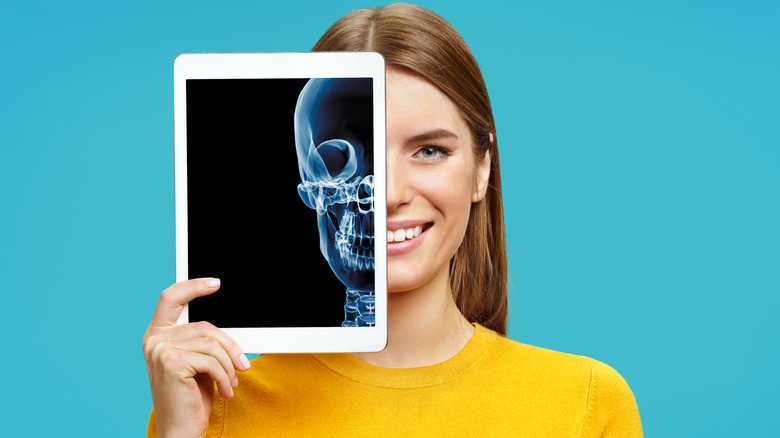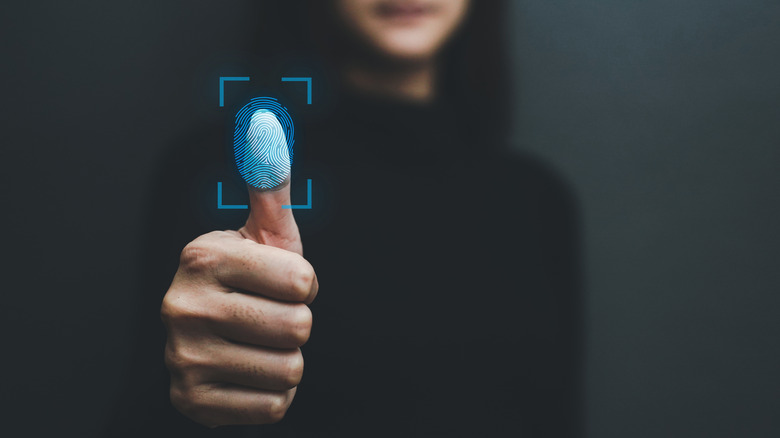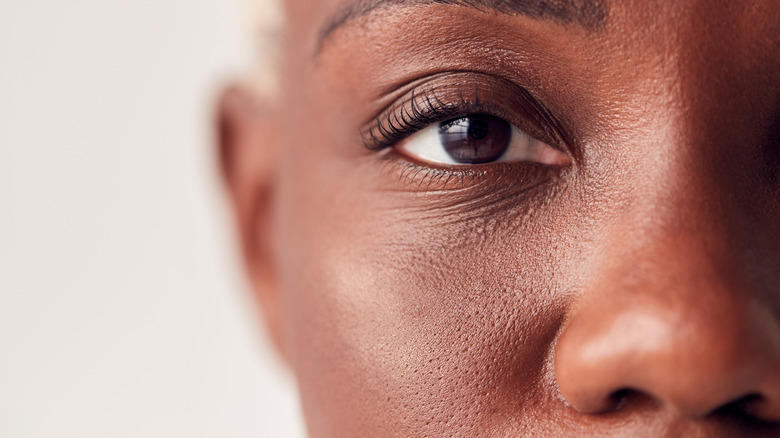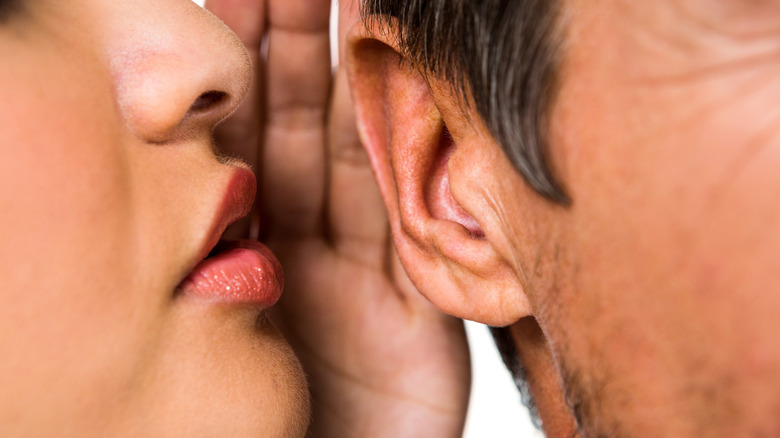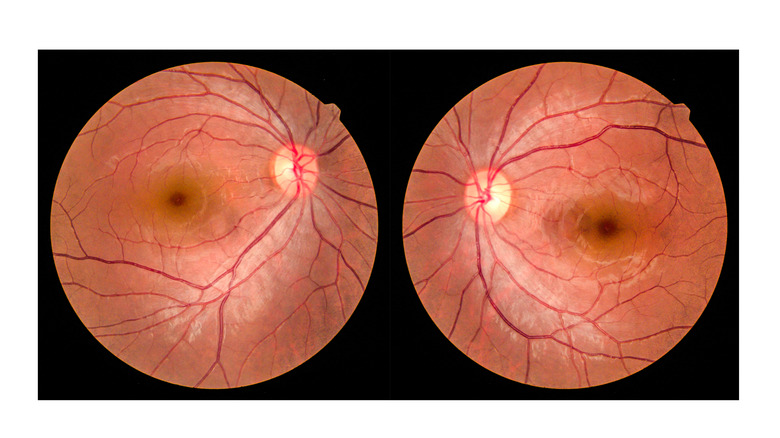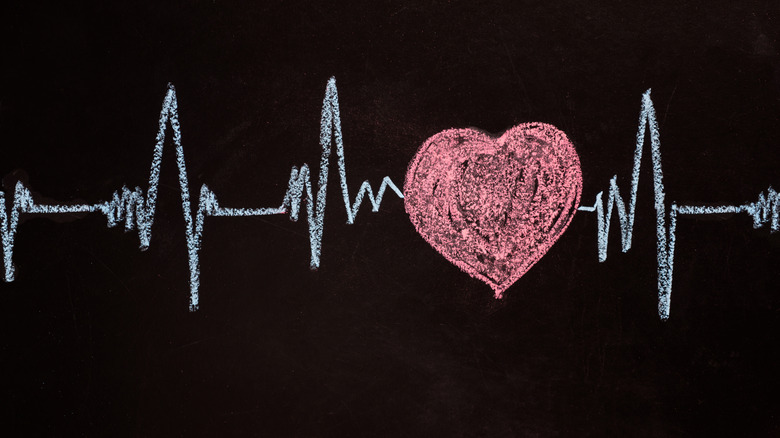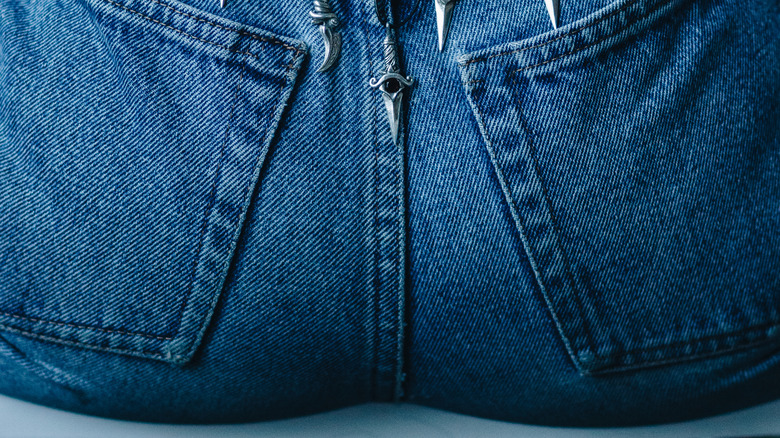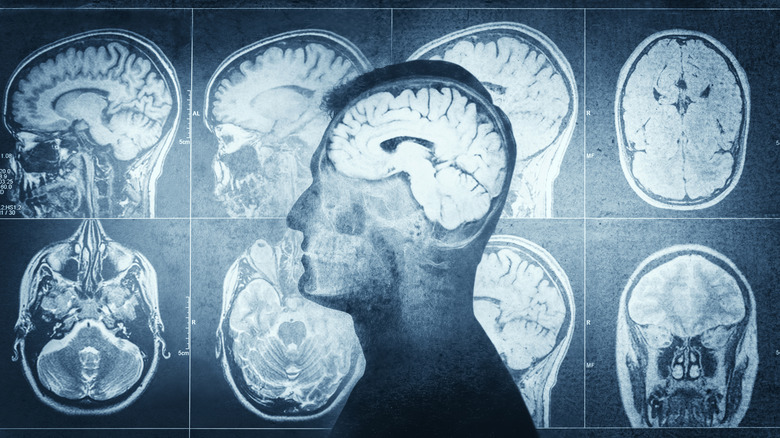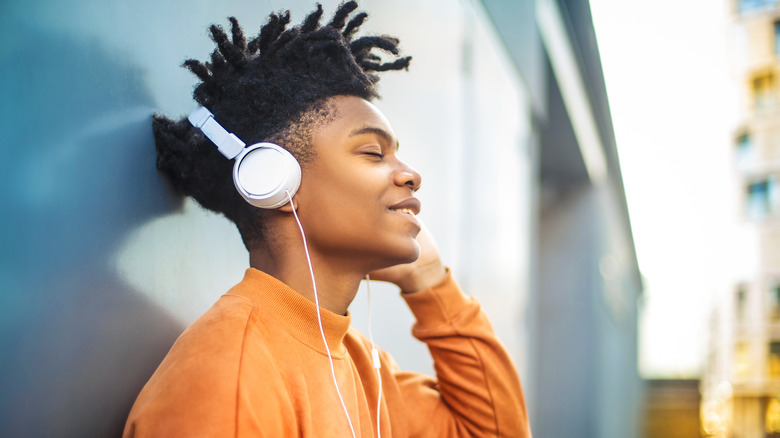Parts Of Your Body That Are Completely Unique
You probably don't realize this, but figuring out who you are is big business. Biometrics are unique physical characteristics that can prove you're you (via the Department of Homeland Security). Companies are scrambling, and spending big bucks, to find ways to detect and use these traits for electronic payments, for preventing data breaches, for tracking employee time and attendance, and for all sorts of commercial purposes (via The Paypers and BiometricUpdate.com).
Central to all of this is the concept that each of us is singular, with distinct physical differences that set us apart from everyone else. We experience this all the time in everyday life, of course, whenever we recognize a familiar face or identify someone by hearing their voice. But not all of our unique qualities are that obvious. Some of them aren't even visible. So to celebrate your uniqueness, let's take a tour of the physical attributes which are particular to you, and you alone, even if you don't know it.
Your fingerprints point to your identity
Perhaps the most famous of unique identifiers, fingerprints are also known as "friction ridge skin," and they're a feature we share with our ape and monkey relatives, according to Scientific American. These skin ridges form in the third month of fetal development, and though they're influenced by multiple genes, the particular patterns are determined by environmental factors in the womb. This means everyone develops fingerprints, also called dermatoglyphs, that are unique to them (via MedlinePlus). Not even identical twins have the same fingerprints.
Because the structure of these skin ridges is determined by attachments below the surface of the skin, superficial burns or abrasions won't change a fingerprint; the pattern will be duplicated as injured skin heals (via Britannica). But why do we have them in the first place? There's no definitive answer, reports LiveScience. It could be that they improve our grip, creating friction between our fingers and the things we touch. Or it may be that they improve our sense of touch. One study that used an artificial touch sensor found that a ridged surface amplified the vibrations that triggered the sensor. Our fingerprints may do the same thing, improving our tactile sensitivity (via Science).
Your eye color is a shade of its own
Your eye color is really the color of your iris, the ring of muscle that surrounds the pupil and opens or closes to let light in or out (per the American Academy of Ophthalmology). It may seem like there are only a few types of eye color ... brown, blue, green, hazel ... but the truth is, there are so many variations that no two people have the exact same eye color.
Eye color, in fact, is a complicated business. Multiple genes interact to produce eye color, so although darker colors tend to be dominant over lighter colors, it's possible for two blue-eyed parents to have a brown-eyed child. They color of the iris is a result of the brown pigment melanin; more melanin means darker eyes. But the distribution of melanin, as well as the amount, can vary widely. The iris has two layers, both of which can contain pigment. If your iris has no pigment in the front layer, your eyes appear blue — which is an illusion caused by blue light being scattered and reflected while other wavelengths are absorbed. People who have brown, green, or hazel eyes have different amounts of pigment in the front and back layers. The pigment can be light or dark brown, and might be distributed unevenly, creating a color variation within the iris. All of these factors combine to give each of us an eye color that's one-of-a-kind.
Your ear has a unique shape
We tend to notice when someone has beautiful or unusual eyes, but have you ever taken note of the shape of someone's ears? Give it a try, and you may be surprised at the variety you encounter. The external ear is known to anatomists as the auricle or pinna, and its various loops and swoops have names too: the helix is the upper, rounded part; the lobule is the dangly bit where your earrings go; and the triangular dealie in front of the ear canal opening is called the tragus (via Britannica). All the variations of the auricle's parts, in all their possible combinations, means the shape of your ear is as individual as a fingerprint. In fact, like fingerprints, "ear prints" left behind by crooks — or images of ears caught on surveillance cameras – can be used to identify suspects in criminal investigations (via Egyptian Journal of Forensic Sciences).
One study examined images of over 2,600 volunteers, using 17 different parameters to compare photographs of their ears, and found that 99.9% of the images were unique enough to be identified. The remaining fraction could be identified with extra analysis. They also found that no one's left and right ears had the exact same shape. Another study found that even identical twins could be identified by the differences in their ear shapes (via ResearchGate).
Your retinas are hard to spoof
Among the various options for biometrics — that is, using biological features to identify people — retinal scans have a lot going for them, according to an academic review of the topic (via ResearchGate). Fingerprints can be replicated, masks can fool facial identification methods, and voice ID systems are sensitive to background noise. Even eye-color detectors might be spoofed by a contact lens. But nobody can change their retinas.
The retina is the layer of light-sensing cells in the back of your eyes (via the American Academy of Ophthalmology). But it's not really the retina that marks you as you, it's the pattern of blood vessels that serves the retina. The uniqueness of this vascular network was first observed in 1935, and in the 1950s researchers established that not even identical twins have the same pattern. The first device designed to scan retinas as a means of identification was developed in 1976 by a company called — and this is honestly the truth — EyeDentify. Because retinal patterns don't change except in the case of eye injury or disease, retinal scanning remains a secure and reliable identification method.
Your teeth tell your story
If your teeth could talk, wow, they could practically tell your whole life story. Of course, talking teeth is a body horror movie nobody needs, especially because it implies the teeth themselves have tiny mouths, with tinier teeth inside them and ...
Anyway, the practice of identifying people by their teeth is called forensic odontology, and it relies on the fact that every tooth has unique characteristics (via the Open Dentistry Journal). The exact placement of the teeth in the mouth is different for everyone as well.
Experts can use teeth to determine the age of unidentified human remains, not only because different teeth emerge at different times of life, but also by examining the mineralization of the teeth (or even a single tooth). A person's occupation and habits can leave evidence on the teeth too: dressmakers and tailors tend to hold needles in their teeth; some people chew on pens or pencils; smoking or chewing tobacco leaves traces. And there are all sorts of dental "anomalies" that individualize our teeth, from spacing or crowding to extra teeth, as well as fillings and other dental work. All of which means your bite mark is totally individual to you. And the roof of your mouth is unique too. Ridges behind the front teeth, called "palatial rugae," are different for everybody.
You have a tongue like no other
"Oh, hey, do you remember me?" *Sticks out tongue.* Maybe that's not likely to catch on in social situations. But in theory, at least, IDing someone by examining their tongue is a real possibility. Like fingerprints and eye color, the texture and other qualities of the human tongue vary from one individual to the next, and are different even among identical twins (via Journal of Forensic Dental Sciences).
There's a reason doctors make you say "aaaaah." Your tongue has a lot to say about you. It can reveal signs of infection, vitamin deficiency, and various diseases (via WebMD). It's also different from any one else's tongue, along multiple parameters: smooth or fissured; the overall shape (categories include elliptical, rectangular, square, round and pentagonal); and measurements like length, width, and thickness (via Journal of Forensic Dental Sciences). Women tend to have a sharper tip than men. And some tongues have unusual features, like geographic tongue, a generally harmless condition that produces "islands" of smooth patches, creating a map-like appearance (via Mayo Clinic).
Your lips say this is me.
The uniqueness of humans lips was first described scientifically in 1902; in 1935 "cheiloscopy," the study of lip prints, was hailed as an important tool by a prominent French (of course) criminologist (via Forensic Science International). A 1972 study of 4,000 lip prints found that each of them was singular. Subsequent research showed that injured lips continue to show their original patterns after they heal.
The patterns in question are wrinkles and grooves found on the surface of the lips, which form as early as the sixth week of life and don't change much during one's lifespan. These markings can be classified according to where on the lips they occur, and by their characteristics: grooves that run vertically across the lips, or stop halfway, or are forked or intersect, and so on. One study published in the Journal of Forensic Dental Sciences found that most people have a mixture of different types of grooves. (Go ahead, check the mirror, you know you're thinking about it.)
Lip prints can be helpful in law enforcement because they can be left behind at crime scenes or by suspects ... on a drinking glass or a cigarette butt, for example. But lip texture, shape, and motion may also become a means for security systems to authenticate people, reports Security Intelligence.
Your heart beats to its own rhythm
On average, the human heart beats 2 billion times in a lifetime (via ScienceAlert). And your 2 billion beats are like nobody else's. One way of measuring the heart's activity is via an electrocardiogram (EKG), which measures the electrical activity that causes the heart's muscles to contract, pumping blood through the circulatory system (via the American Heart Association). Among the information it records is that classic spiked wave pattern you've seen on a million medical dramas (usually just before it flatlines and people start yelling dramatic things like "Code blue!" or "Dibs on the beach house!"). The shape of that wave tells doctors a lot about how the heart is functioning — or what's going wrong. But while the general pattern is the same for every healthy heart, it's affected by the heart's size, shape, and position, reports The Economist.
Since it would be hard to imitate another person's heartbeat — you can't grab it off a drinking glass like you could a fingerprint — heartbeat recognition has been proposed as a way of establishing identity for security purposes (via MIT Technology Review). It may even be possible to read someone's signature heartbeat from a distance.
Your skeleton is a memoir in bone
It's not really true that dead men tell no tales. The bones we leave behind offer a surprisingly thorough record of who we were in life. It's just a matter of knowing how to read them. A trained eye can spot the differences between the skeleton of a man and a woman; not only do women have a wider pelvis, there are six other pelvic differences to check for (via the UK's National History Museum). Characteristics of the skull can also be used to determine sex. Age can be estimated by bone growth; until about age 30, bones still show signs of growth. Some bones of the skull don't fuse completely until one's late 30s. After that, certain bones begin to deteriorate with age. Some age-related ailments, like arthritis, leave traces on the skeleton.
Can your skeleton reveal your race? Forensic anthropologists, whose job it is to determine the identity of human remains, are moving away from making claims about "race" in favor of determining the likely ancestry of a particular subject, according to a review article in Forensic Sciences Research. The idea is to avoid using outdated racial classifications. But measurements and other features of a skeleton, especially the skull, can suggest if the deceased was of African, European, or Asian ancestry. And DNA samples taken from bone may turn up genetic markers that can help flesh out the story.
Your hand holds a map of your identity
Imagine if you could establish your bona fides just by waving. It would be the friendliest identity verification ever. Plus you'd always have your ID at hand ... because your ID would be your hand. Our hands are full of anatomical features that could be used to differentiate us from each other (via the Encyclopedia of Biometrics). Our fingerprints, of course, are widely known as distinguishing features. Your palm prints are also unique. But there are deeper distinguishers than that. For example, the 27 bones of the hand can vary in their geometry, giving your hand a bone structure unique to you. However, images of those bones would be hard to acquire, and the differences might be too subtle to be easily detected. Similarly, the muscles of your hand may have a singular contour, but they're also hard to image outside of an MRI machine, and tend to lose their shape with age.
A more promising candidate for handy identification is the network of veins beneath your skin (via ComputerWorld). While we all have the same basic map of blood vessels throughout our body, their exact placement is unique to each of us. And veins are relatively easy to image using low-cost infrared scanners, since they absorb more infrared light than the surrounding tissue. In Japan, banks are already using such scanners to grant ATM access without a card.
Your butt is no joke
Are you sitting down? That might be all you need to do in order to prove who you are, if butt-recognition technology reaches its full potential. Researchers at the Tokyo-based Advanced Institute of Industrial Technology (AIIT) developed a pressure-sensitive sensor that identifies who's sitting on it, using 360 sensors to detect unique contours and pressure points, reports BBC Future. It even identifies sitting style, recognizing someone by how they slouch or which cheek they favor. Yes, this technology invites comments about the "end user" and similar cheeky humor (See? Even we couldn't resist). But it makes sense if you think about it: Imagine a car that will only operate if the owner is in the driver's seat, or a computer that automatically logs in when its authorized user sits down.
Unfortunately, since the AIIT's first announcement of the device in 2012, there hasn't been much news about its development or commercial application. So it looks like we'll have to sit on our hands and hope the idea hasn't fallen though the cracks. (Oh God, we did it again. So sorry).
You have a unique ecosystem inside you
There's no such thing as being home alone, really, because each of us is home to a multitude of microorganisms that consider our body to be a nice neighborhood to settle in and raise a few bazillion progeny (via the National Institute of Environmental Health Sciences). And just like every neighborhood has its own character, the ecosystem of microbes in your body—your "microbiome"—is different from those of other people (via Gizmodo).
One way to detect those differences is to examine the microbes found in stool samples. In one study, researchers compared the genetic material from microorganisms in the fecal matter of nearly 250 people, using a custom computer algorithm to identify the data and test the uniqueness of each sample (via PNAS). They found that the differences in microbiomes were an effective "microbial fingerprint," enabling correct identification of the donor 86% of the time. The study also showed that the makeup of our internal residents doesn't change much over time, with some samples still matching their origin after 300 days or more. This line of research may lead to new methods of identifying people, but also raises privacy concerns: supposedly anonymous medical data that includes microbiome info may not be so anonymous.
Your brain is shaped by who you are
If the movie "Young Frankenstein" taught us anything it's that all brains look alike, at least to the layman. But if you're a neuroscientist, instead of a mad scientist's lackey, the distinct differences between one brain and the next are easier to discern. Brain anatomy can be influenced by both genetics and environment, and since those factors are different for everyone, it follows that each person's brain structure might also be a little different (via Scientific Reports). To put this to the test, researchers examined MRI brain scans of 191 people, and assessed more than 500 anatomical features for each, including total brain volume and measurements of over 100 specific brain areas. They found that each brain had a specific combination of features, allowing identification with 90% accuracy.
While it used to be thought that the human brain had no individual features, this research adds evidence to the contrary. "The combination of genetic and non-genetic influences clearly affects not only the functioning of the brain, but also its anatomy," study author and professor of neuropsychology Lutz Jäncke said in a press release from the University of Zurich.
Your skull makes its own music
We hear with our ears, of course, but we can also hear with our head: "Bone conduction" is the phenomenon of sound waves being conducted through the bones of the skull (via Britannica). When those waves cause the skull to vibrate, we perceive sound. The principle of bone conduction is used for sound transmission in some types of hearing aids and headphones (via Duke Health and Men's Journal).
Sound that travels through your head passes through a combination of bone, cartilage, tissue, and fluid that's uniquely your own. Researchers wondered if this change in the audio signal could be detected, and used to identify individuals. So they developed a system called SkullConduct, an eyeglass-type device that plays a short bit of white noise and records the sound to evaluate how it's been modified by the wearer's skull. In a small test with 10 volunteers, the device was able to identify people with 97% accuracy. SkullConduct was based on Google Glass, the "smart eyewear" that didn't exactly take off (via MSN). So it remains to be seen if this method of identification has any practical use. But the research is a good reminder that each of us has a unique way of experiencing the world.
